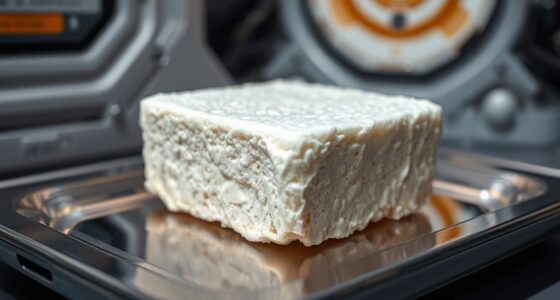Gelato, ice cream, and frozen custard differ mainly in ingredients and texture. Gelato has less fat and air, making it denser, richer, and more flavorful. Ice cream contains more cream and overrun, resulting in a lighter, fluffier feel. Frozen custard adds egg yolks, giving it a creamy, velvety texture. These differences in composition and process shape how each treat tastes and feels—if you want to discover how, keep exploring the science behind them.
Key Takeaways
- Gelato has lower fat and air content, resulting in a denser, more intense flavor and velvety texture.
- Ice cream contains more cream and air (overrun), making it lighter, fluffier, and easier to enjoy over time.
- Frozen custard includes egg yolks, giving it a smoother, creamier, and more custardy mouthfeel.
- The interaction of ingredients during freezing and churning determines each treat’s final density and texture.
- Ingredient variations, such as fat, eggs, and air, directly influence the sensory experience of each frozen dessert.

When it comes to frozen treats, gelato, ice cream, and frozen custard often get mixed up, but each offers a unique experience. One of the most noticeable differences lies in their texture differences, which are directly influenced by ingredient variations. As you indulge, you’ll notice that gelato has a denser, smoother texture that melts quickly on your tongue. This is because gelato contains less air—called overrun—than traditional ice cream, making it feel richer and more velvety. Ice cream, on the other hand, tends to be lighter and fluffier due to higher overrun levels, which incorporate more air into the mixture during churning. This added air creates a softer, more voluminous texture that’s easy to scoop and enjoy.
Frozen custard stands apart with its unique texture, thanks to its specific ingredients. It’s made with egg yolks, which give it a creamier, silkier consistency than standard ice cream. The inclusion of eggs also means that frozen custard has a slightly denser and more substantial mouthfeel, even more so than gelato. The ingredient variations in each treat considerably influence their final textures. Gelato’s base is primarily milk, sugar, and flavorings, with very little cream, resulting in a less fatty but intensely flavorful experience. Ice cream relies heavily on cream and sometimes butterfat, which contributes to its lightness but also its richness. Frozen custard’s key ingredient—egg yolks—adds body and a smooth, custardy quality that’s hard to match. Additionally, the texture differences are a result of how each treat’s ingredients interact during freezing, churning, and storage.
Understanding these ingredient variations helps you appreciate why each treat feels different when you eat it. Gelato’s lower fat content and minimal air make it feel denser and more intense, so you experience the flavor more directly. Ice cream’s higher fat and air content create a lighter, more airy sensation, making it easier to enjoy for longer periods. Frozen custard’s eggs provide a richness that’s more indulgent and velvety, giving it a luxurious mouthfeel. These differences aren’t just about taste; they’re about the science of how ingredients interact during freezing and churning. The fat content, air incorporation, and inclusion of eggs all influence how these treats develop their textures, ultimately shaping your sensory experience. Knowing these distinctions allows you to pick the perfect frozen treat based on your texture preferences and flavor expectations.
Frequently Asked Questions
How Do Fat Content Differences Affect Texture and Flavor?
You’ll notice that higher fat content really impacts the texture and flavor, making it richer and creamier. Fat enhances flavor richness by carrying taste compounds and creates a smoother mouthfeel. If an ice cream or gelato has less fat, it’ll feel lighter and less indulgent, but might highlight other ingredients more. So, the fat content directly influences how luxurious and flavorful your frozen treat feels on your palate.
What Role Does Air Incorporation Play in the Three Desserts?
Think of air incorporation as the breath of life in your dessert. In gelato, less air creates a dense, velvety texture, while ice cream and frozen custard incorporate more air, making them lighter and fluffier. This air quality influences dessert density, giving each treat its unique mouthfeel. More air means a softer, more buoyant experience, whereas less air results in a richer, creamier bite that sticks to your palate.
How Does Serving Temperature Influence Taste and Consistency?
Serving temperature greatly affects your taste and texture perception. When you serve gelato slightly warmer than ice cream, it enhances flavor and creates a smoother, creamier texture. Cooler temperatures make desserts seem firmer and less flavorful. By adjusting the temperature, you can enjoy better flavor enhancement and more satisfying texture perception, ensuring your dessert experience is rich and enjoyable every time.
Are There Health Benefits Unique to Each Frozen Treat?
Ever wondered if your favorite frozen treat offers unique health perks? Gelato often contains less fat, making it a lighter choice, while frozen custard’s higher protein content can support muscle repair. Ice cream provides calcium, essential for bones. Depending on your dietary restrictions, you might prefer one for fewer additives or lower sugar. Each offers distinct nutritional benefits that can complement your health goals—so choose what best serves your lifestyle.
How Do Storage Methods Impact Freshness and Quality?
Proper storage techniques and preservation methods are key to maintaining freshness and quality. You should keep your frozen treats at consistent, low temperatures, ideally in airtight containers to prevent freezer burn and flavor loss. Avoid frequent temperature fluctuations, as they cause ice crystals to form, compromising texture. By following these techniques, you guarantee your gelato, ice cream, or custard stays delicious and maintains its intended consistency longer.
Conclusion
Now that you know the incredible science behind gelato, ice cream, and frozen custard, you’re practically a dessert superhero! Whether you choose the velvety richness of gelato, the classic chill of ice cream, or the creamy decadence of frozen custard, you hold the power to elevate your sweet game to legendary status. So go ahead—dive into these frozen worlds and indulge like the dessert champion you’re destined to be!









